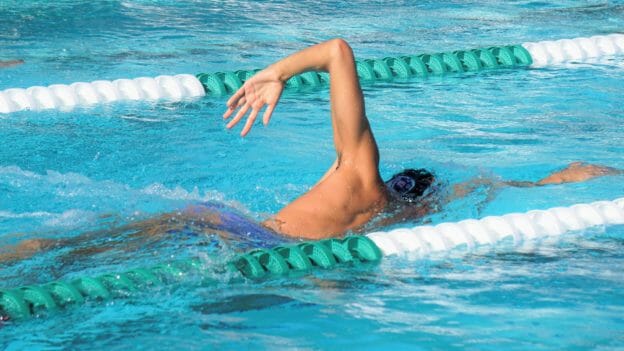At The Race Club we use the analogy of Octane ratings in gasoline to describe the different arm recovery motions in freestyle. Octane is a low molecular weight hydrocarbon that is an additive to gasoline, and which helps the engine run more efficiently, particularly at high compression. Metaphorically, the words High Octane have become synonymous with powerful or dynamic in the English language.
Low Octane
The easiest way to get the arm back out in front of you after a freestyle pull is by bending the elbow, relaxing the wrist, and allowing the hand to barely clear the water as it moves forward through the air. We refer to that technique of arm recovery as Low Octane, because it requires the least amount of work to get the job done and produces the least amount of kinetic energy.
Most swimmers first learn to do freestyle with a Low Octane, bent-arm recovery. Most distance swimmers and triathletes use a Low Octane, bent-arm recovery to conserve energy for the many pulling motions they will need to do during the longer races. Examples of elite distance swimmers using this technique include Katie Ledecky, Zane Grothe, Sun Yang, and many others.
Medium Octane
As the races shorten to 100 meters, we often see the swimmer’s hands elevate from the water’s surface with a straighter recovering arm. We refer to this less bent-elbow recovery as Medium or Medium-High Octane recovery. This recovery technique requires more work and produces more kinetic energy during the recovery motion. There is only one reason why we would want to make the recovery more difficult and that is to swim faster. With the correct timing, more kinetic energy in the recovering arm will generate more propulsion in the pulling arm. We call that coupling and that leads to a faster swim. Examples of elite athletes using this recovery technique would include Nathan Adrian and Simone Manuel.
High Octane
In the one sprint event of swimming, the 50-meter race, we often see the swimmer’s arms completely straight or nearly completely straight on the recovery motion. We refer to this as High Octane freestyle recovery. Similar to a high combustion engine, the sprinter typically has more fast twitch fibers in the muscle composition than the distance swimmer. They then benefit from using this higher energy recovery technique to generate greater propulsion. Examples of elite sprinters using High Octane freestyle recovery include Florent Manaudou, Anthony Ervin, Ben Proud, Abby Weitzel, and Pernille Blume.
While there are many exceptions to using these different recovery techniques, we also find some swimmers that will use different arm recoveries with each arm. Lotte Friis, the elite Danish distance swimmer, is a notable example of that, using High Octane recovery with the left arm and Low Octane recovery with the right arm. Other swimmers will change their recovery technique (and stroke rate) during a race. Nathan Adrian is quite famous for finishing his 100-meter freestyle races with a High Octane freestyle recovery; something coach Mike Bottom taught him to do at The Race Club in 2008.
In conclusion, while most swimmers learn to swim freestyle with a Low Octane, bent elbow recovery for sprinting or mid distance races, elevating your Octane Rating on your recovery may be a good technique to try. You may just win a few more races.
This week, in Lanes 1-4 (complimentary) of The Race Club subscription, you will find an excellent webisode showing various swimmers using the different recovery techniques. We hope you enjoy it.
Yours in swimming,
Gary Sr.

